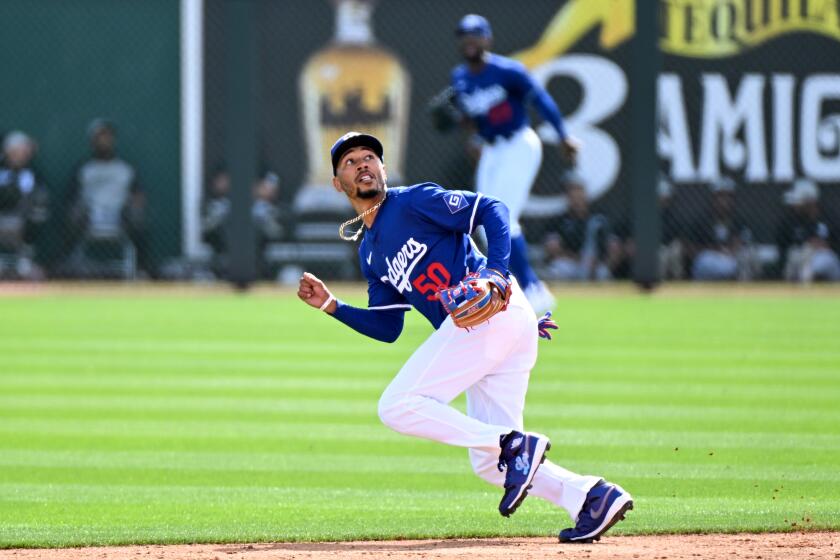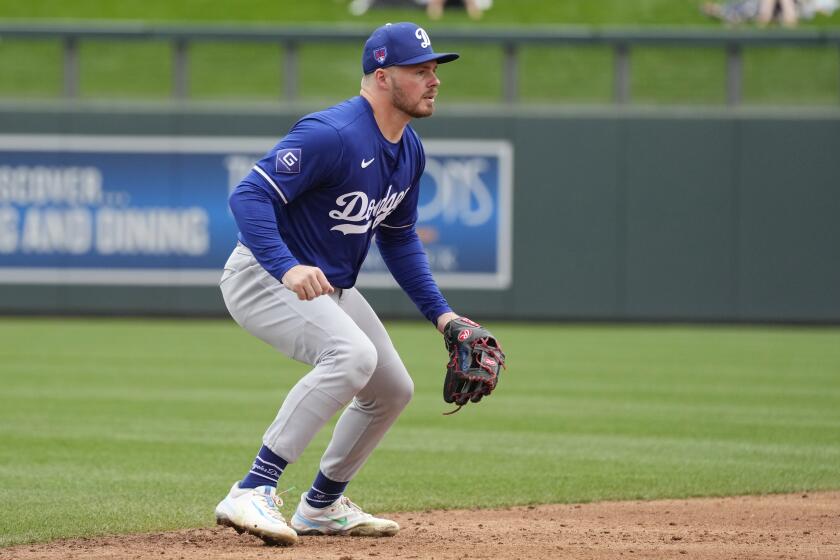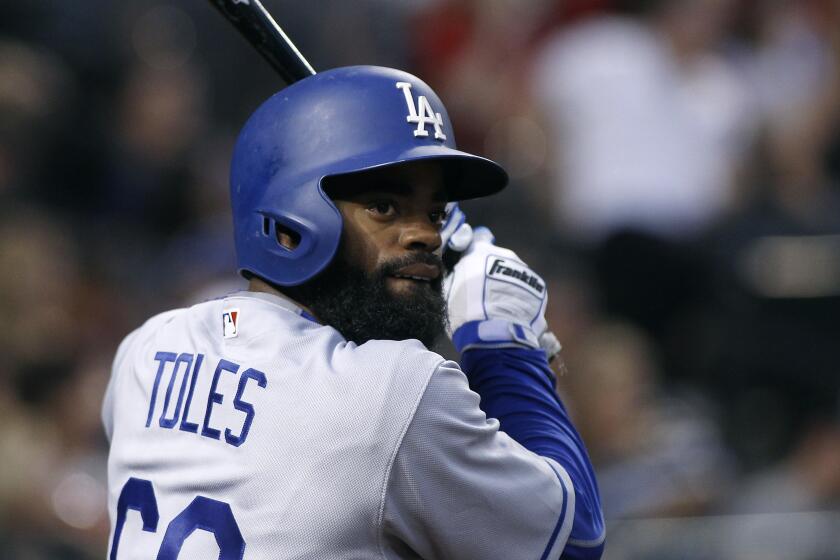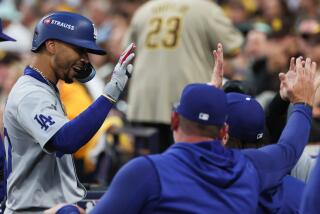‘I believe in myself’: Examining the challenges of Mookie Betts’ move to shortstop
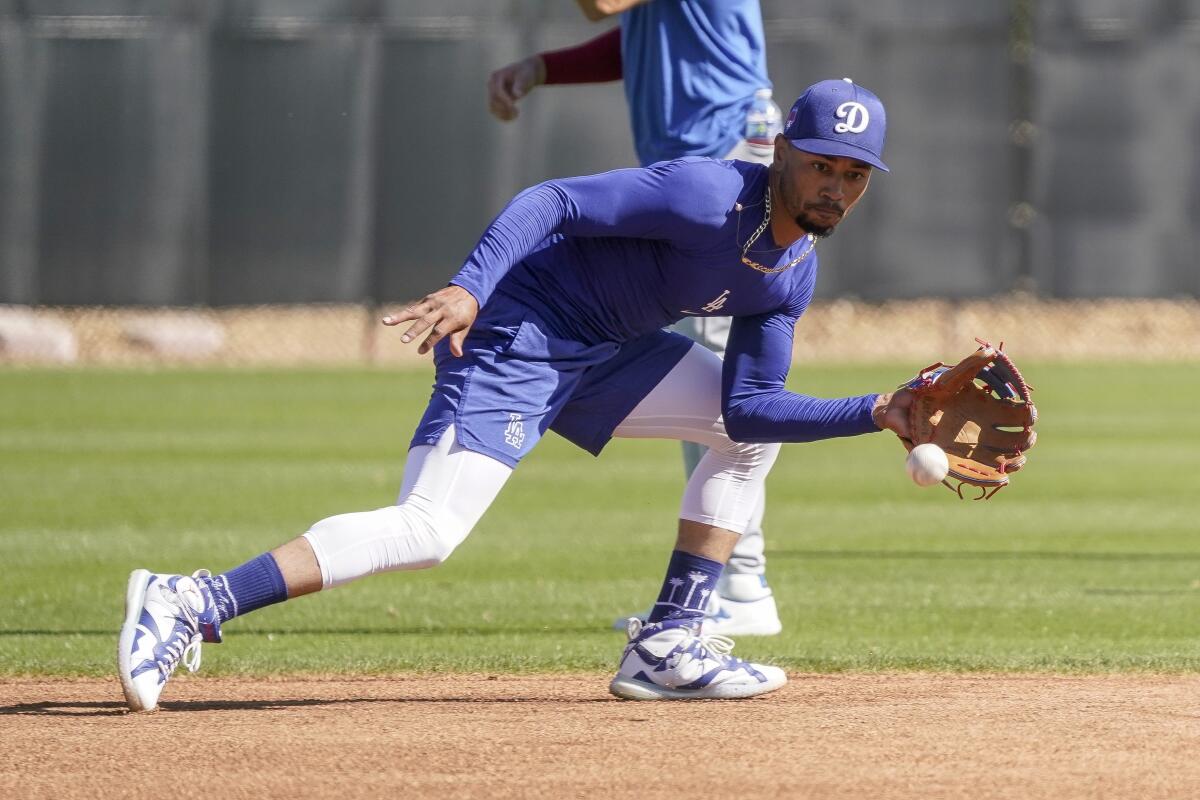
- Share via
PHOENIX — As most of his teammates trickled back into the clubhouse following a morning practice at Camelback Ranch last week, Mookie Betts remained planted on the infield dirt of Field 2 at the Dodgers’ spring training facility.
Then, for several minutes, he took grounder after grounder after grounder from the left side of the diamond — the latest step in his rigorous process to transition to a new defensive position.
It had only been a couple days since the former Gold Glove right fielder, who was already preparing to play second base full time this season, was informed that he would instead be taking over as the Dodgers’ starting shortstop to begin the upcoming campaign.
The position isn’t foreign to Betts, who grew up playing shortstop before the Boston Red Sox moved him to the outfield as a minor leaguer more than a decade ago.
“I believe in myself,” Betts said this week, before the team’s Thursday flight to South Korea for its season-opening series against the San Diego Padres. “That’s the most important thing.”
The Dodgers had all offseason to address Gavin Lux’s difficulty playing shortstop. Instead, they’re forcing Mookie Betts to quickly fix their mess.
But the task is nonetheless daunting — evidenced by the former most valuable player’s immediate increase in fielding drills last week, many of them under the watchful eyes of infield coach Dino Ebel and special assistant Chris Woodward.
“He’s an elite athlete for a reason,” Woodward said. “That’s the way his mind works. No challenge is too big for him.”
At least, that’s what the Dodgers are anxious to believe.
Even for a player as gifted as Betts — a seven-time All-Star widely considered one of the most well-rounded players in the sport — making a short-notice switch to arguably the toughest defensive position on the diamond is hardly a recipe for seamless success.
After all, the Dodgers only made the move because Gavin Lux, who was supposed to be the team’s shortstop this season, struggled mightily in the field this spring after returning from a torn ACL he suffered last year.
A safer replacement for Lux, at least defensively, would have been smooth-fielding veteran Miguel Rojas, who took over as the team’s primary shortstop last year after Lux’s injury.
However, the Dodgers wanted to keep Lux’s bat in the lineup.
So, the team opted for the more radical — and risky — route of flipping Lux to second base and Betts over to shortstop.
“Obviously, it’s a challenge taking on that position and the demands of it,” general manager Brandon Gomes said of Betts. “But I know that he’s up for it, and he’s certainly capable of it. … Anything he does, I will not bet against him figuring out how to do extremely well.”
To the untrained eye, the difference between shortstop and second base might not seem extreme.
Quick hands and nimble feet are essential for both positions. The reads on ground balls are similar, albeit flipped visually. Instincts for other responsibilities like turning double plays and making relay throws to home plate are needed at either position as well.
Those basics Betts already has down.
“He was born a shortstop,” Woodward noted. “Certain guys, you just look at them and can tell they played shortstop their whole life. And he pretty much did, until pro ball basically.”
In what manager Dave Roberts called a “permanent, for now” move, the Dodgers announced Gavin Lux is being moved to second base after his struggles at shortstop.
The true challenge of the position is the consistency required on an inning-to-inning, day-to-day, 162-game basis.
“The hardest thing is all the easiest things actually,” Betts said. “Doing the easiest things the right way every single time.”
The longer throw to first, for example, demands not only added arm strength, but dependable fundamentals with footwork and body alignment.
“There’s no lob throw to first base,” Woodward said. “If you do that, you get in trouble. That’s where careless errors come in.”
As the de facto captain of the infield, there is also a mental burden of ensuring proper positioning and decision making on each play.
“I know he’s gonna be OK catching and throwing the ball, making the routine plays,” Rojas said. “It’s all about how can he continue to communicate with whoever is playing third, whoever is playing second … and the plays he is making away from the ball.”
“There’s a lot of plays,” Rojas added, “where the shortstop is involved.”
The grind of the position seemed to take a toll on the Rojas last year. While the 35-year-old started a team-high 108 games at short, he also battled several nagging injuries throughout the campaign, including a two-week injured list stint for a hamstring strain in late April.
As a result, the team’s shortstop depth was so thin at times that Betts started 12 games at the position himself. It was his first official game action at the spot since his single-A season in 2012. And of his 46 chances to make a play, he committed three errors (coming out to a pedestrian, though small-sample, fielding percentage of .935).
“It’s a lot,” Rojas said. “Playing shortstop in the big leagues is, I say, one of the hardest things to do in the sport.”
In Betts’ case this year, it will all be compounded by his significant offensive responsibilities as the team’s leadoff hitter.
When playing shortstop last year, Betts batted .304 with a 1.039 OPS (slightly better than his overall mark of .987, which ranked fifth in the majors). Maintaining that production while playing short every day, however, will increase the magnitude of difficulty.
“We’re already asking a lot of Mookie,” Rojas said. “Hitting from the leadoff spot and getting five at-bats every single day, while playing [shortstop] every single day, is tough.”
Gomes also acknowledged the potential risks of moving Betts to shortstop, and was already bracing himself for fan blowback “if things don’t get off to a screaming start.”
“Of course there is downside; there is downside with any move that you make,” the general manager said. “But when looking at our team in totality, and what is going to help us win the most games, we felt as an organization that this was the decision.”
Indeed, belief around the organization in Betts’ ability to thrive at shortstop remains high with opening day fast approaching.
Rojas praised his teammate’s “diligence” in fielding drills over the last week, having worked alongside him for several sessions of infield work.
“We know he’s a superstar, but he’s not selfish or like, ‘I know what to do,’” Rojas said. “He wants to continue to get better. That’s the good thing about Mookie.”
Woodward and Ebel have already seen Betts refine his consistency during his daily infield drills.
Andrew Toles last played in 2018. The Dodgers apparently renewed his contract so he could keep his insurance while dealing with mental health issues.
“During games, Dino always tells him, ‘Just be Mookie,’” Woodward said. “So we’re gonna train him to be the most consistent Mookie, so that when it comes to game time, it’s just about letting his true athleticism make a play.”
Betts conceded he feels some nerves about the switch. He described the move to shortstop, especially after all his years in right field, as a “huge” change.
“You’re going from one of the easier positions on the field [in right field], to one of the hardest outside of catching,” he said.
Yet, as reporters peppered him with questions in front of his locker this week, the new starting shortstop also expressed an unwavering sense of confidence — embracing both the challenge of his new role, and an optimistic outlook he is hoping, and the Dodgers are gambling, will come to fruition.
“I think the most important thing I’ve learned is that I can do it,” Betts said. “I really believe I can do it. I trust I can do it. The coaches believe in me. And we’re putting in all the work. I think just that positive mind-set will take me a long way.”
More to Read
Are you a true-blue fan?
Get our Dodgers Dugout newsletter for insights, news and much more.
You may occasionally receive promotional content from the Los Angeles Times.

